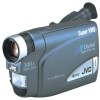JVC GR-SX851U Instruction Manual - Page 47
Battery Packs, Cassettes
 |
UPC - 046838158049
View all JVC GR-SX851U manuals
Add to My Manuals
Save this manual to your list of manuals |
Page 47 highlights
Battery Packs The battery packs are nickel-cadmium or nickel metal-hydride batteries. Before using the supplied battery pack or an optional battery pack, be sure to read the following cautions: 1. To avoid hazard . . . ... do not burn. ... do not short-circuit the terminals. ... do not modify or disassemble. ... use only specified chargers. Terminals 2. To prevent damage and prolong service life . . . ... do not subject to unnecessary shock. ... avoid repeated charging without fully discharging. ... charge in an environment where temperatures are within the tolerances shown in the chart below. This is a chemical reaction type battery-cooler temperatures impede chemical reaction, while warmer temperatures can prevent complete charging. ... store in a cool, dry place. Extended exposure to high temperatures will increase natural discharge and shorten service life. ... avoid prolonged uncharged storage. ... remove from charger or powered unit when not in use, as some machines use current even when switched off. NOTES: ● It is normal for the battery pack to be warm after charging, or after use. Temperature Range Specifications Charging 10°C to 35°C (50°F to 95°F) Operation 0°C to 40°C (32°F to 104°F) Storage 10°C to 30°C (14°F to 86°F) ● Recharging time is based on room temperature of 20°C (68°F.) ● The lower the temperature, the longer recharging takes. EN47 Cassettes To properly use and store your cassettes, be sure to read the following cautions: 1. During use . . . ... make sure the cassette bears the VHS-C mark. ... be aware that recording onto prerecorded tapes automatically erases the previously recorded video and audio signals. ... make sure the cassette is positioned properly when inserting. ... do not load and unload the cassette repeatedly without allowing the tape to run at all. This slackens the tape and can result in damage. ... do not open the front tape cover. This exposes the tape to fingerprints and dust. 2. Store cassettes . . . ... away from heaters or other heat sources. ... out of direct sunlight. ... where they won't be subject to unnecessary shock or vibration. ... where they won't be exposed to strong magnetic fields (such as those generated by motors, transformers or magnets). ... vertically, in their original cases.















